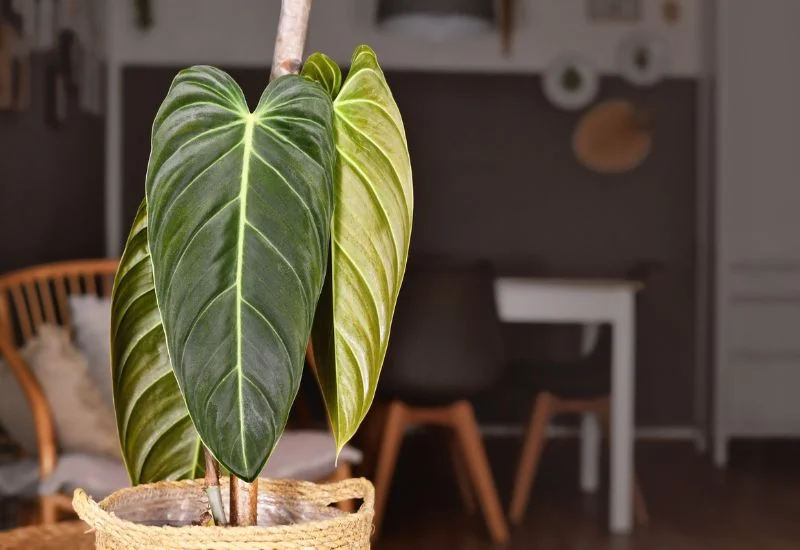In this blog post, you’re going to learn how to easily propagate and care for Philodendron melanochrysum.
This is a comprehensive guide covering reliable information about different aspects of this cultivated variety.
In this post, I’ll cover:
- Interesting Facts
- Propagation
- Repotting
- Care
And
- Solutions to Common Problems
So, if you are looking to propagate and care forPhilodendron melanochrysum, this guide is for you.
Fun Facts
Philodendron melanochrysum is also known as “Black and Gold.” It is named for the golden veins that pass through its dark leaves. The leaves are initially golden but later turn dark green.
| Common Name | Black Gold Philodendron, Melanochrysum Plant, Melano Philodendron |
| Botanical Name | Philodendron melanochrysum |
| Family | Aracae |
| Plant Type | Vining plant, Perennial |
| Fruit | Rarely produce fruit |
| Mature Size | Reach up to 18 feet ( 5.5 meters ) |
| Sun Exposure | Partial indirect sunlight to moderate direct sunlight |
| Soil Type | Fertile, well-drained, high in organic matter |
| Soil pH | 5.5 to 6.0 / Acidic |
| Native Area | Colombia, South America |
| Toxic | The sap contains calcium oxalate, which is toxic |
| Growth | Fast growth |
It was discovered over 130 years ago in tropical and subtropical areas.
The leaves of Philodendron melanochrysum are heart-shaped with elongated structures. Their color is dark green, but they have silvery white veins. This velvety foliage makes it an adorable houseplant.
You will not see the Philodendron melanochrysum flower indoors. They produce flowers rarely, only in their native natural environment.
Benefits
Philodendron melanochrysum has several benefits. It can absorb several toxins along with carbon dioxide, including formaldehyde and benzene. This will clean the air and provide clean oxygen to breathe comfortably.
Its adaptability makes it easy to handle. You don’t have to make an effort to maintain the specific conditions for this plant.
Propagation
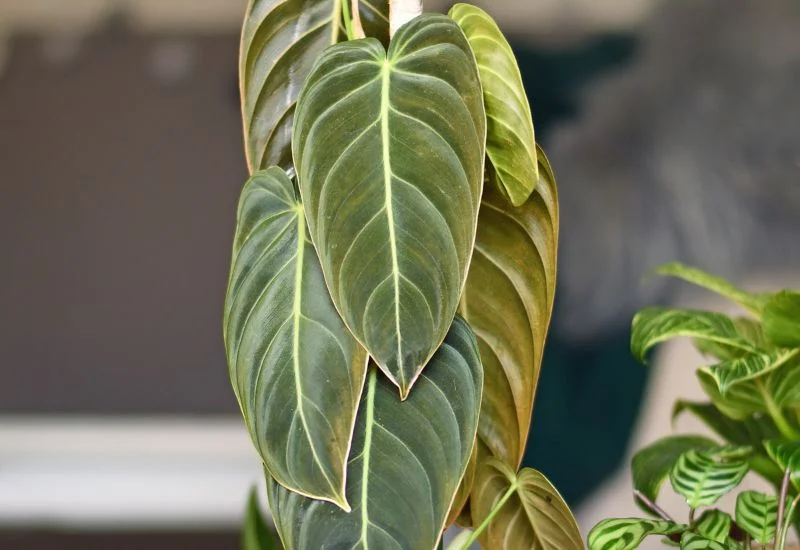
You can either buy a new Philodendron melanochrysum plant or propagate it from your existing plant to increase the number of plants you have. You can easily propagate them through stem cuttings in your home by following these steps.
- Find out a healthy branch with several leaf nodes.
- Cut it with a disinfected and sharp knife at an angle to increase the surface area. Remove some of the leaves to expose their nodes.
- Now put this stem cutting in the water. You have to wait for two or three weeks for the roots to appear.
- When the roots become two or three inches, you should put them in the pot. Ensure that the soil of the pot is loose and soft.
- You have to water them daily to keep the soil moist for the first few weeks.
In this way, you can propagate this plant. However, you have to keep in mind some tips for better propagation.
- Always wait for the spring season for propagation.
- Change the water of the container regularly to maintain cleanliness.
- You can dip the stem cutting in the growth hormone for better results.
Repotting
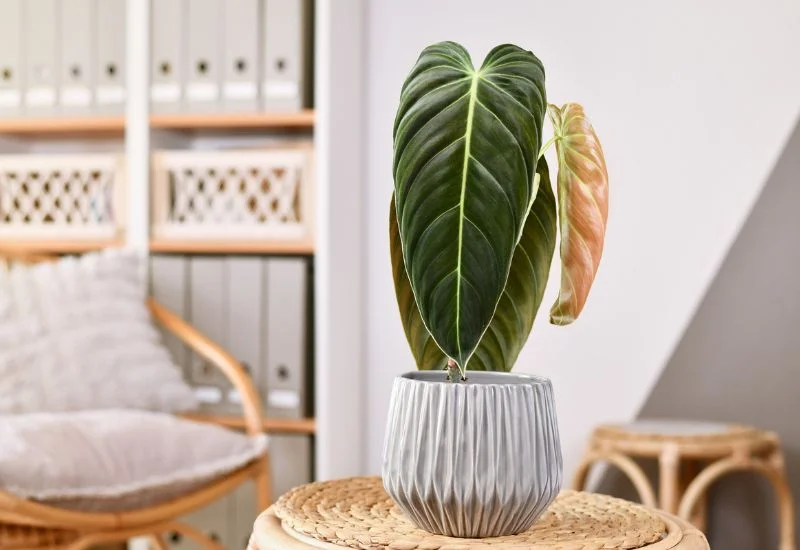
Change of the pot is not recommended for this Philodendron, but if you can, repot it when you observe the following signs.
- The roots sprouting out of the holes of the pot.
- Stuntness in the growth.
- Drooping of the leaves
Now, you should select a pot of two to three inches bigger in size. It should have proper drainage holes. Furthermore, report in the growing seasons that are spring and summer.
You can follow the steps given below for repotting your plant.
- Remove your plant from the pot without damaging the roots.
- Prepare a well-drained, organic, fertile, and well-aerated soil mixture.
- Hold that plant in the center of the new pot. Then put the soil around the plant slowly.
In this way, you are done with repotting.
Care
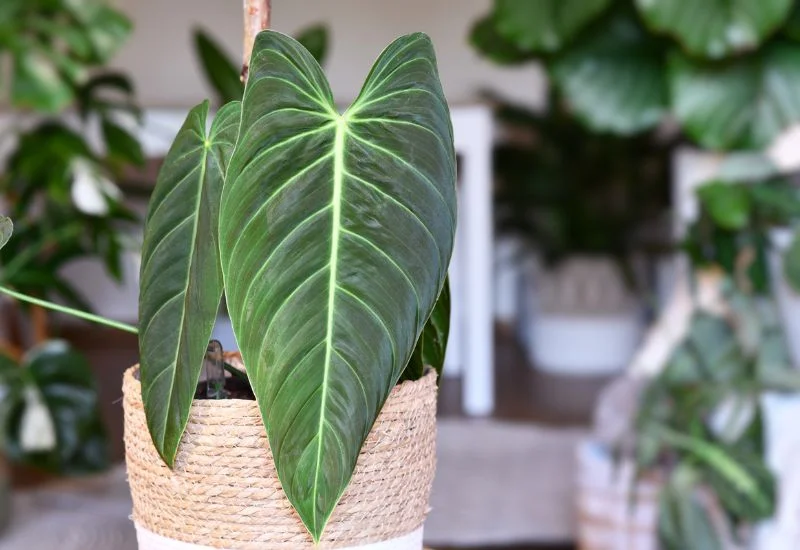
If you want optimum growth of your Philodendron melanochrysum, you have to imitate their natural habitat. They belong to tropical regions with warm and humid climates.
Temperature
Tropical regions have a temperature between 25 to 28 degrees Celsius. So you can keep your Philodendron at 21 to 28 °C (70°F – 90°F). Humidity level above 60% is suitable for this plant.
Pruning
This species of Philodendron doesn’t need pruning frequently. However, if there are dead or diseased leaves or branches, you can remove them from the plant. For pruning this plant, you will need a disinfected, sharp pair of scissors. You have to find the damaged or dead leaves. Then, cut them from some inches above the node. In this way, you can prune this plant.
Soil
The ideal soil for this plant is porous, light, fertile, moisture-retaining, and well-draining. It will provide a balanced quantity of air and water. To make such soil, you have to mix the following constituents.
- Peat moss
- Perlite
- Orchid bark
Pot
As this is a crawling plant, you have to select a wide pot. It should have drainage holes. The minimum diameter of the pot for Philodendron melanochrysum is 12 cm. However, you can select a pot of any size greater than this.
Water
The general rule for watering this Philodendron is to water only when the upper 2 to 3 inches of soil become dry. The gap between watering will decrease in spring and summer, while it will increase in autumn and winter. Moreover, water only to keep the soil moist, not enough to cause waterlogging.
Light
This plant requires eight to ten hours of indirect but bright sunlight. You can place it under direct sunlight only when it is not burning. This plant can tolerate direct sunlight in the morning and afternoon. However, in the middle of the day, its sensitive leaves will burn.
Placement
You should place your plant in a spot with maximum bright indirect sunlight. This spot can be in your living room, lawn, kitchen, bathroom, house jungle, etc. Moreover, you can place your Philodendron near the east or north-facing windows.
Fertilizer
Philodendron melanochrysum needs adequate amounts of nutrients during its growth phase. Lack of nutrients slows down its growth rate. So, you have to use soluble fertilizers to fulfill the needs of nutrients. It is recommended to use the soluble, high-nitrogen fertilizer.
You can provide 10-10-10 NPK fertilizer once a month during spring and summer to increase the growth. In autumn and winter, decrease the fertilization to once in two months.
Common Problems
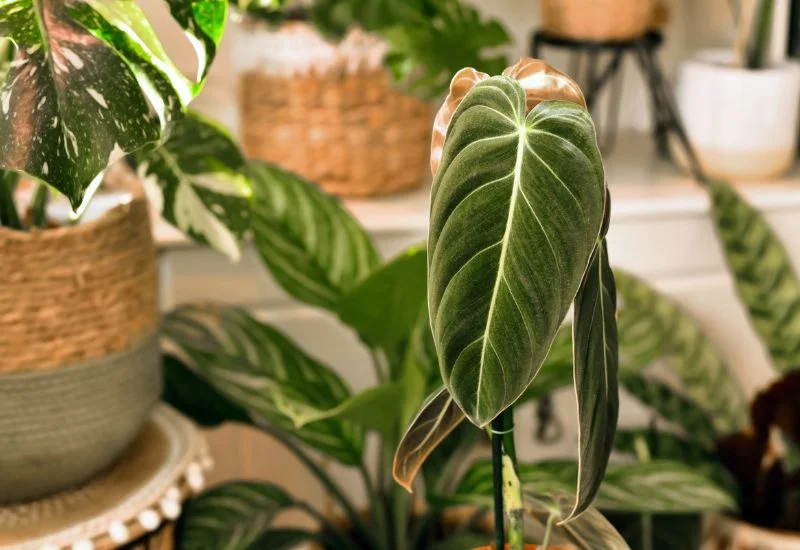
Pests
This plant is vulnerable to several pests, such as spider mites, mealy bugs, scale
bugs, aphids, thrips, and fungus gnats. They can appear in different forms on the leaves. Some form a dark spot, some form white webs, colored speckles, etc.
When you observe any of the pest’s symptoms on the leaves, treat them immediately. They actually utilize all the nutrients from the sap and increase their population. First of all, wipe the leaves off with a cloth dipped in alcohol. Then, you can spray the leaves with neem oil or citronella oil.
Fungal and Bacterial Diseases
Fungi and bacteria can cause several diseases in the Philodendron melanochrysum. You will observe black lesions, rusts, halos, and black spots in the leaves. These are caused due to several reasons such as the following.
- Poor sanitation
- Poor drainage
- Infected plants can spread pathogens in your healthy plant
You can spray your plant with fungicides to treat such issues. At the same time, you should isolate your infected plant from the other healthy plants.
Brown Tips
Leaves form brown tips mostly due to the accumulation of salts or fertilizers in them. Over fertilizing is the main cause behind this. Moreover, overfertilizing in the dormant phase can even result in worse consequences.
To avoid such issues, you should fertilize once a month in a balanced quantity. While in the dormant phase, reduce this fertilization. Additionally, you can wash the soil to remove excessive quantities of fertilizers.
Curling Leaves
Leaves mostly curl due to the low humidity and fewer hours of bright indirect sunlight. But this problem can be treated. You can increase the humidity by misting it with water spray or installing a humidifier near this plant.
Root Rotting
Philodendron melanochrysum has sensitive roots. These roots can rot due to water logging in the pot. This can be caused due to poor drainage or overwatering.
Therefore, you have to keep the following tips in mind to prevent root rotting.
- Use a pot with proper drainage holes.
- Use well-drained soil.
- Water only when the upper one or two inches are fully dried.
- Prefer dryness over waterlogging.
Moreover, you should change the pot and trim the rotted roots.
Yellow leaves
People grow this plant because of its leaves. But for several reasons, these leaves become yellow and result in wilting. Some of the most common causes of yellowing of the leaves are given below.
- Overwatering
- Prolonged direct sunlight
- Under watering
- Less indirect sunlight
- Low humidity
Therefore, maintain proper conditions for treating this issue.
Varieties & Similar Plants
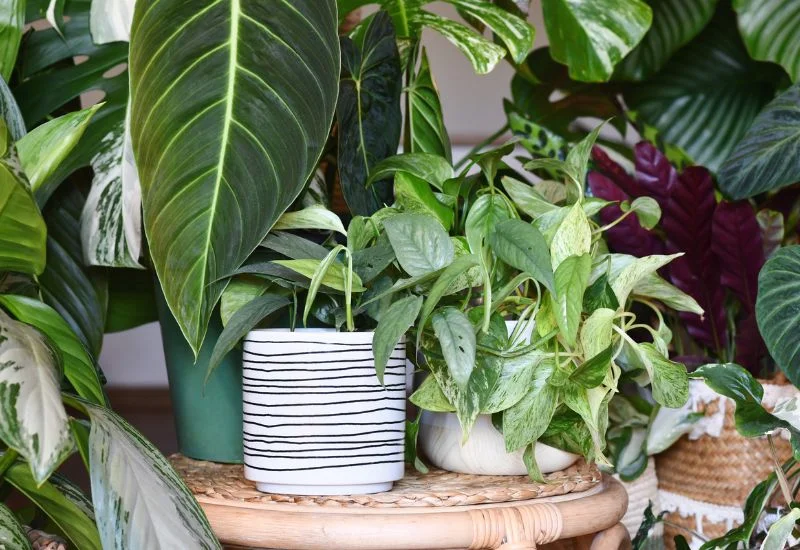
P.Melanochrysum has similarities with many other Philodendron species. Following are some of them.
- Philodendron Hederaceum
- Philodendron Micans
- Philodendron Verrucosum
Philodendron Golorious
This Philodendron species results from the cross of Melanochrysum and Gloriosum. It has features of both these species. You will observe a velvety texture and dark green color in its leaves.
Ready to Grab a Philodendron melanochrysum to add beauty to your home garden?
All the above information is reliable, and you’ll see outstanding results if you want to grow or care for this plant.
